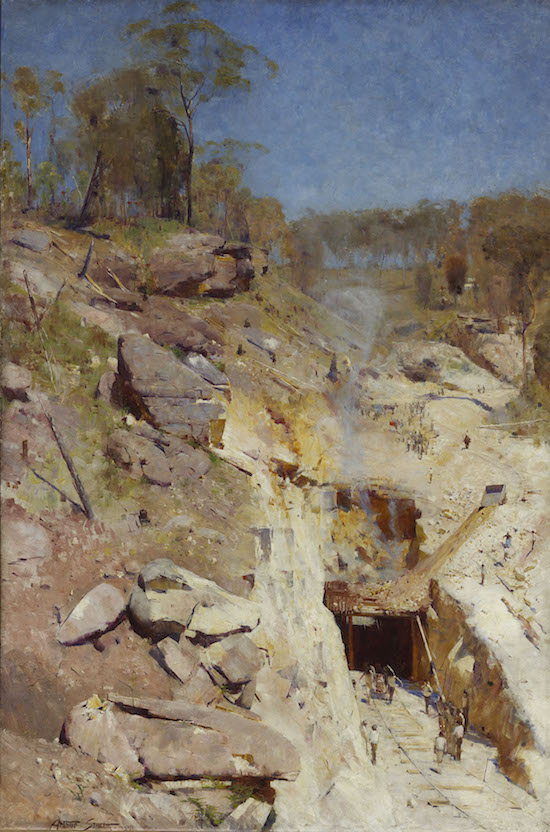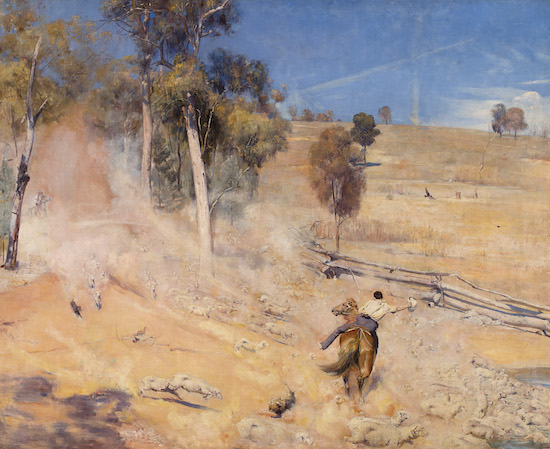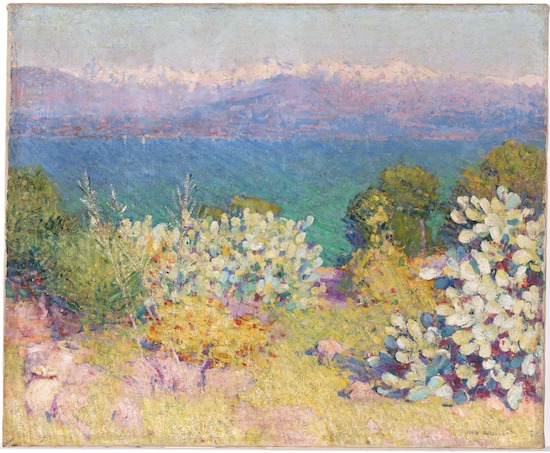John Russell, In the Morning, Alpes Maritimes from Antibes, 1890-1, Oil on canvas, 60.3 × 73.2 cm, National Gallery of Australia, Canberra, Purchased 1965 © National Gallery of Australia, Canberra
Australia’s Impressionists, currently on show at the National Gallery, is the first exhibition in the UK dedicated exclusively to works produced by a group of Australian artists towards the end of the 19th century. Arthur Streeton (1867-1943), Tom Roberts (1856-1931) and Charles Conder (1868-1909) are identified as key players in the movement’s evolution, but it’s the inclusion of John Russell’s (1858-1930) work that goes further than attributing the influence of European styles on Australian art and attempts to shed light on the dialogue which existed between the two.
The exhibition came about as a result of the long-term loan of Blue Pacific (1890) by Arthur Streeton to the National Gallery in 2015. This was the first occasion for a painting by an Australian artist to be shown at the gallery and instigated a desire to introduce the movement to wider audiences.
Although the Australian Impressionists were primarily based in the growing urban environments of Sydney and Melbourne, they shared an impulse to paint en plain air in the latter’s rural outskirts of Heidelberg. Drawing on their collective admiration for Turner, Whistler and French Impressionism, as well as having studied or exhibited in Europe, these depictions of the pastoral were considered daring and avant-garde. These visions of the Australian outback were first shown to city-dwellers in 1889 at the 9 by 5 Impression Exhibition at Melbourne’s Buxton Rooms. Over a hundred and eighty glimpses into bush and town life were painted on wooden cigar box lids measuring nine times five inches. These early vignettes are dominated by Whistler’s influence and depict a grim industrial landscape, rather than the blue skies and golden outback used in the National Gallery’s promotional material. The impact of this exhibition is used to frame the opening section at Australia’s Impressionists and immediately introduces the unconventional nature of Impressionism when crafted by members of the Heidelberg School.
The exhibition was phenomenally successful and helped to establish the movement as one of Australia’s first distinctive visual styles. However, the reception was not entirely congratulatory. Writing in The Argus, the critic James Smith described the works as ‘destitute of all sense of the beautiful’. In response to this review, Arthur Streeton wrote a letter to the editor of the newspaper that has since been regarded as a manifesto of sorts:
"It is better to give our own idea than to get a merely superficial effect, which is apt to be a repetition of what others have done before us, and may shelter us in a safe mediocrity, which, while it will not attract condemnation, could never help towards the development of what we believe will be a great school of painting in Australia."
Thus, the painters continued to venture into Australia’s vast outback and remarkable coastlines in a bid to capture Australia as authentically as possible. It is no coincidence that their impetus to carve out a distinctive national identity, albeit tied to European traditions, was taking place in the years running up to Federation in 1901. Whereas the scenes found in the 9 by 5 Impression Exhibition were pocket-size, the section devoted to national landscape involves a change of palette, size and tone. Arthur Streeton’s Fire’s On (1891) and Tom Roberts’ A Break Away! (1891) particularly stand out for their vibrant use of azure and gold. You can barely stand in front of these works without feeling the heat radiate off them and the choking dust coming from runaway sheep or an explosion in a rocky hillside.

Arthur Streeton, Fire’s On, 1891, Oil on canvas, 183.8 × 122.5 cm, Art Gallery of New South Wales, Sydney, Purchased 1893 © AGNSW
Despite presenting these works as fundamental to the movement and its sense of national pride, the exhibition could have done more to address how such images helped in the myth-making of Australia’s colonial past. The heroism of pioneers and their resilience against a brutal, alien environment, according to Edmund Capon, “had played a lead role in Australia’s coming-of-age.” Capon, the former director of the Art Gallery of New South Wales (which helped organise this exhibition), scrutinised Australian Impressionism in a TV series called The Art of Australia, first aired in 2015. The Heidelberg School is presented as youthful, driven and experimental; by taking their easels outside of the studio, they were able to faithfully record the golden terrains in a way that “were immortalised” and “firmly fixed in the Australian psyche.”
While John Russell’s works provide a stark contrast to the landscape paintings of his fellow countrymen, they move the focus of the exhibition onto a Francophile’s vision of Europe before visitors can sufficiently question the colonial imagery being presented. Russell’s paintings are chaotic, both in colour and brushstroke; pinks, purples and yellows flourish in meadows and varying shades of blue zigzags dance upon seascapes. It is quite easy to get distracted by the hallucinatory effect of these pieces, yet unsurprising to learn that Russell mingled with the likes of Monet, Van Gogh and Matisse. Russell’s contributions to Australian art history broke away from the myth-making of the Heidelberg School, but placing him at the end of the exhibition does more to reinforce him as ‘Australia’s lost Impressionist’ than successfully scrutinise the movement and assess its reception in Europe.
Brief references to the Australian Impressionists exhibiting in London and Paris at the turn of the century are made, but as Gary Werskey argues, they ‘were used not only as advertisements for skilled migrants and signals of impending nationhood but also as signs of the rewards for Australia (and other white settler societies) for their continuing support of the ‘new imperialism’.’

Tom Roberts, A Break Away!, 1891, Oil on canvas, 137.3 x 167.8 cm, Art Gallery of South Australia, Adelaide, Elder Bequest Fund 1899 © Art Gallery of South Australia, Adelaide
In many ways, the exhibition itself comes across as an impression of this period, rather than a truly accurate and in-depth portrayal of life in Australia. While a painting like Fire’s On may depict the real dangers of construction that went into building a nation, it illustrates one aggressively white male narrative. To ascribe these painters so much influence on Australia’s art history and national identity is to oversimplify matters. It is deceiving to suggest that Australian art began with the Heidelberg School or their European predecessors. What about the five hundred centuries before European settlers arrived?
In her study of Aboriginal history in New South Wales, Heather Goodall, Professor of History at University of Technology Sydney, writes that ‘the Heidelberg School of painters chose not to include an Aboriginal presence in their self-consciously heroic depictions of Australian life and land.’ Despite Indigenous populations working widely in the rural labour which Streeton and Roberts celebrated, they are removed from these contexts and reduced to subjects of ethnographic photography.
This exhibition concentrates on four artists who immersed themselves so deeply in their bucolic idylls that the realities of colonialism were overlooked and would only begin to emerge almost a century later. Rather than continuing to perpetuate the heroic myth of the settler, there was potential to re-evaluate the legacy of these works and how they can be read through a post-colonial lens. Following in the footsteps of the Royal Academy’s Australia exhibition in 2013, this may be the first time an exhibition at the National Gallery was devoted to Australian art, but I hope that one day they will be as daring and diverse with the narratives they present as John Russell was with his paintbrush.
Australia’s Impressionists is at the National Gallery, until 26 March


